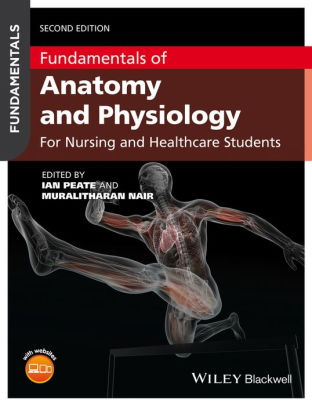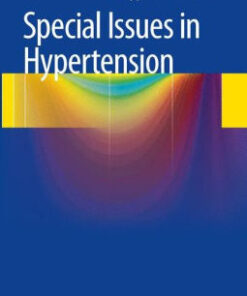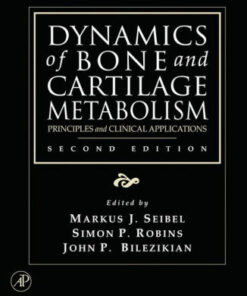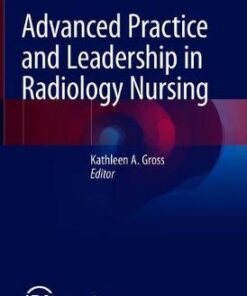(PDF) Fundamentals of Anatomy and Physiology 2nd Edition by Ian Peate
$18.00
Download instantly Fundamentals of Anatomy and Physiology – For Nursing and Healthcare Students 2nd Edition by Ian Peate, Muralitharan Nair. It is ebook in PDF format.
ISBN-10: 1119055520 ISBN-13: 9781119055525
Preview
This is the PDF eBook version for Fundamentals of Anatomy and Physiology – For Nursing and Healthcare Students 2nd Edition by Ian Peate, Muralitharan Nair
Table of Contents
Contributors xx
Acknowledgements xxii
Preface xxiii
Prefixes, suffixes xxvii
How to use your textbook xli
About the companion website xlii
Chapter 1 Basic scientific principles of physiology 1
Peter S Vickers
Introduction 2
Levels of organisation 2
Characteristics of life 2
Bodily requirements 4
Atoms 4
Atomic number 5
Carbon atom 5
Molecules 6
Chemical bonds 6
Ionic bonding of atoms 7
Ions 7
Covalent bonds 8
Polar bonds 10
Electrolytes 10
Elements 11
Properties of elements 12
Compounds 12
Chemical equations/chemical reactions 13
Acids and bases (pH) 15
Blood and pH values 17
Homeostasis 17
Organic and inorganic substances 18
Examples of organic substances 18
Examples of inorganic substances 19
Units of measurement 19
Conclusion 22
Glossary 22
References 24
Activities 24
Chapter 2 Cells, cellular compartments, transport systems, fluid movement between compartments 29
Muralitharan Nair
Introduction 30
Cell membrane 32
Functions of the cell membrane 33
Cellular fluid compartments 34
Intracellular fluid 35
Extracellular fluid 36
Fluid movement between compartments 37
Composition of body fluid 38
Effects of water deficiency 38
Variation in body fluid content 39
Transport systems 40
Simple diffusion 40
Facilitated diffusion 41
Osmosis 42
Filtration 43
Active transport system 43
Electrolytes 46
Functions of electrolytes 47
Hormones that regulate fluid and electrolytes 50
Antidiuretic hormone 50
Aldosterone 51
Atrial natriuretic peptide 52
Parathyroid hormone 52
Conclusion 52
Glossary 53
References 54
Further reading 54
Activities 54
Chapter 3 Genetics 61
Peter S Vickers
Anatomical map 62
Introduction 62
The double helix 63
Nucleotides 63
Bases 64
Chromosomes 65
From DNA to proteins 67
Protein synthesis 67
Key steps in protein synthesis 69
Summary of protein synthesis 72
The transference of genes 74
Mitosis 74
Meiosis 76
First meiotic division 78
Mendelian genetics 79
Dominant genes and recessive genes 81
Autosomal dominant inheritance and ill health 81
Autosomal recessive inheritance and ill health 81
Morbidity and mortality of dominant versus recessive disorders 84
X-linked recessive disorders 85
Spontaneous mutation 86
Conclusion 86
Glossary 87
References 89
Further reading 89
Activities 90
Chapter 4 Tissue 95
Anthony Wheeldon
Introduction 96
Epithelial tissue 96
Simple epithelium 97
Stratified epithelium 100
Glandular epithelia 102
Connective tissue 102
Connective tissue proper 105
Cartilage 106
Bone 107
Liquid connective tissue 107
Membranes 107
Cutaneous membranes 107
Mucous membranes 108
Serous membranes 109
Synovial membranes 109
Muscle tissue 110
Nervous tissue 112
Tissue repair 112
Conclusion 113
Glossary 113
References 115
Activities 115
Chapter 5 The skeletal system 121
Ian Peate
Body map 122
Introduction 122
The axial and appendicular skeleton 122
The axial skeleton 123
The appendicular skeleton 123
Bone and its functions 123
Support 123
Movement 126
Storage 126
Protection 127
Production 127
Bone formation and growth (ossification) 128
Embryonic formation 128
Intramembranous ossification 129
Endochondral ossification 130
Bone length and thickness 130
Bone remodelling 130
Bone fractures 132
Bone structure and blood supply (histology) 134
Blood supply 135
Organisation of bone based on shape 135
Long bones 136
Short bones 136
Flat bones 139
Irregular bones 139
Sesamoid bones 139
Joints 140
Fibrous joints 140
Cartilaginous joints 141
Synovial joints 141
Conclusion 144
Glossary 144
References 146
Further reading 146
Activities 147
Chapter 6 The muscular system 153
Janet G Migliozzi
Body map 154
Introduction 154
Types of muscle tissue 154
Smooth or visceral muscle 154
Cardiac 155
Skeletal 155
Functions of the muscular system 155
Maintenance of body posture 155
Production of movement 155
Stabilisation of joints 155
Protection and control of internal tissue structures/organs 155
Generation of heat 156
Composition of skeletal muscle tissue 156
Gross anatomy of skeletal muscles 156
Microanatomy of skeletal muscle fibre 157
The sarcolemma and transverse tubules 157
The sarcoplasm 157
The myofibrils 159
The sarcomeres 159
Types of muscle fibres 159
Blood supply 160
Skeletal muscle contraction and relaxation 160
Energy sources for muscle contraction 163
Aerobic respiration 163
Oxygen debt 164
Muscle fatigue 165
Organisation of the skeletal muscular system 165
Skeletal muscle movement 168
The effects of ageing 177
Conclusion 178
Glossary 178
References 178
Further reading 179
Activities 179
Chapter 7 Circulatory system 185
Muralitharan Nair
Body map 186
Introduction 186
Components of blood 186
Properties of blood 188
Plasma 188
Water in plasma 188
Functions of blood 188
Formation of blood cells 190
Red blood cells 190
Haemoglobin 192
Formation of red blood cells 192
Life cycle of the red blood cell 194
Transport of respiratory gases 195
White blood cells 196
Neutrophils 196
Eosinophils 197
Basophils 197
Monocytes 198
Lymphocytes 198
Platelets 199
Haemostasis 199
Vasoconstriction 199
Platelet aggregation 199
Coagulation 199
Blood groups 202
Blood vessels 203
Structure and function of arteries and veins 204
Capillaries 207
Blood pressure 207
Physiological factors regulating blood pressure 208
Control of arterial blood pressure 208
Lymphatic system 208
Lymph 208
Lymph capillaries and large lymph vessels 210
Lymph nodes 210
Lymphatic organs 213
Spleen 213
The thymus gland 214
Functions of the lymphatic system 214
Conclusion 214
Glossary 215
References 216
Further reading 216
Activities 217
Chapter 8 The cardiac system 223
Carl Clare
Body map 224
Introduction 224
Size and location of the heart 224
The structures of the heart 225
Heart wall 225
The heart chambers 227
The blood supply to the heart 230
Blood flow through the heart 233
The electrical pathways of the heart 234
The cardiac cycle 239
Factors affecting cardiac output 243
Regulation of stroke volume 243
Preload 243
Force of contraction 244
Afterload 244
Regulation of heart rate 244
Autonomic nervous system activity 245
Baroreceptors and the cardiovascular centre 245
Hormone activity 245
Conclusion 247
Glossary 247
References 250
Further reading 250
Activities 251
Chapter 9 The digestive system 257
Louise McErlean
Body map 258
Introduction 258
The activity of the digestive system 258
The organisation of the digestive system 259
The digestive system organs 259
The mouth (oral cavity) 259
Pharynx 263
Oesophagus 264
The structure of the digestive system 266
Stomach 267
Small intestine 272
The pancreas 274
The liver and production of bile 276
The functions of the liver 278
The gallbladder 278
The large intestine 278
Digestive tract hormones 281
Nutrition, chemical digestion and metabolism 281
Nutrients 281
Balanced diet 282
Nutrient groups 283
Conclusion 286
Glossary 287
References 291
Further reading 291
Activities 292
Chapter 10 The renal system 299
Muralitharan Nair
Body map 300
Introduction 300
Renal system 300
Kidneys: external structures 301
Kidneys: internal structures 303
Nephrons 306
Functions of the kidney 309
Blood supply of the kidney 311
Urine formation 313
Filtration 313
Selective reabsorption 313
Excretion 314
Hormonal control of tubular reabsorption and secretion 315
Angiotensin and aldosterone 316
Antidiuretic hormone 316
Atrial natriuretic peptide 316
Composition of urine 317
Characteristics of normal urine 318
Ureters 320
Urinary bladder 320
Urethra 322
Male urethra 322
Female urethra 323
Micturition 323
Conclusion 324
Glossary 325
References 325
Further reading 326
Activities 326
Chapter 11 The respiratory system 333
Anthony Wheeldon
Body map 334
Introduction 334
Organisation of the respiratory system 334
The upper respiratory tract 335
The lower respiratory tract 336
Larynx 337
Trachea 338
Bronchial tree 338
Blood supply 341
Respiration 341
Pulmonary ventilation 343
The mechanics of breathing 343
Work of breathing 345
Volumes and capacities 346
Control of breathing 347
External respiration 348
Gaseous exchange 348
Factors influencing diffusion 349
Ventilation and perfusion 352
Transport of gases 352
Transport of oxygen 353
Transport of carbon dioxide 355
Acid–base balance 355
Internal respiration 358
Conclusion 358
Glossary 358
References 362
Further reading 363
Activities 363
Chapter 12 The reproductive systems 371
Ian Peate
Body map 372
Introduction 372
The male reproductive system 373
The testes 373
Spermatogenesis 375
Sperm 376
The testes and hormonal influences 377
The scrotum 379
The penis 380
Epididymis 382
The vas deferens, ejaculatory duct and spermatic cord 382
The prostate gland 382
The female reproductive system 382
The primary genitalia 382
The internal organs 389
The external genitalia 392
The breasts 393
Conclusion 394
Glossary 394
References 396
Further reading 397
Activities 397
Chapter 13 The nervous system 403
Louise McErlean and Janet G Migliozzi
Body map 404
Introduction 404
Organisation of the nervous system 404
Sensory division of the peripheral nervous system 405
Central nervous system 405
Motor division of the peripheral nervous system 406
Somatic nervous system 406
Autonomic nervous system 406
Neurones 406
Dendrites 407
Cell body 408
Axons 408
Myelin sheath 408
Sensory (afferent) nerves 408
Motor (efferent) nerves 409
The action potential 409
Simple propagation of nerve impulses 409
Saltatory conduction 409
The refractory period 409
Neurotransmitters 411
Neuroglia 411
The meninges 412
Cerebrospinal fluid 413
The brain 415
Cerebrum 415
Diencephalon 417
Brainstem 418
Cerebellum 418
The limbic system and the reticular formation 418
The peripheral nervous system 419
Cranial nerves 420
The spinal cord 420
Functions of the spinal cord 420
Spinal nerves 421
The autonomic nervous system 426
Sympathetic division (fight or flight) 426
Parasympathetic division (rest and digest) 426
Conclusion 430
Glossary 430
References 432
Further reading 432
Activities 433
Chapter 14 The senses 439
Carl Clare
Introduction 440
The chemical senses 440
The sense of smell (olfaction) 440
The sense of taste 445
The senses of equilibrium and hearing 449
The structure of the ear 449
Equilibrium 452
Hearing 455
The sense of sight 459
Lacrimal apparatus 460
The eye 460
The processing of visual information 468
Conclusion 469
Glossary 469
References 471
Further reading 472
Activities 472
Chapter 15 The endocrine system 479
Carl Clare
Body map 480
Introduction 480
The endocrine organs 481
Hormones 482
The transportation of hormones 484
Effects of hormones 485
Control of hormone release 485
Destruction and removal of hormones 486
The physiology of the endocrine organs 486
The hypothalamus and the pituitary gland 486
Hormones released by the anterior pituitary gland 488
Growth hormone 488
Prolactin 489
Follicle-stimulating hormone and luteinising hormone (gonadotrophins) 489
Thyroid-stimulating hormone 489
Adrenocorticotrophic hormone 489
The thyroid gland 490
The parathyroid glands 494
The adrenal glands 495
Adrenal medulla 496
Adrenal cortex 497
Mineralocorticoids 497
Glucocorticoids 498
Pancreas 500
Insulin 501
Glucagon 503
Somatostatin 504
Conclusion 504
Glossary 504
References 505
Further reading 506
Activities 507
Chapter 16 The immune system 513
Peter S Vickers
Body map 514
Introduction 514
Blood cell development 514
Organs of the immune system 517
The thymus 517
The lymphatic system 518
Lymph nodes 520
Lymphoid tissue 522
The spleen 522
Types of immunity 523
The innate immune system 523
Physical barriers 523
Mechanical barriers 523
Chemical barriers 524
Blood cells 524
Blood cells of the immune system 524
The acquired immune system 531
Cell-mediated immunity (T-cell lymphocytes) 531
Humoral immunity (B-cell lymphocytes) 533
Immunoglobulins (antibodies) 535
Immunoglobulin G 536
Immunoglobulin A 536
Immunoglobulin M 536
Immunoglobulin E 537
Immunoglobulin D 537
Role of immunoglobulins 538
Natural killer cells 541
Primary and secondary response to infection 541
Primary immune response 541
Secondary immune response 542
Immunisations 543
Passive immunisation 543
Active immunity 543
Conclusion 543
Glossary 544
References 546
Further reading 546
Activities 547
Chapter 17 The skin 551
Ian Peate
Body map 552
Introduction 552
The structure of skin 553
The epidermis 553
Keratinocytes 553
Melanocytes 554
Langerhans cells 555
Merkel cells 555
Layers of the epidermis 555
Stratum basale 557
Stratum spinosum 557
Stratum granulosum 557
Stratum lucidum 558
Stratum corneum 558
The dermis 558
The papillary and reticular aspects 558
The accessory skin structures 559
The hair 559
Skin glands 561
Nails 562
The functions of the skin 563
Sensation 563
Thermoregulation 564
Protection 565
Excretion and absorption 566
Synthesis of vitamin D 567
Conclusion 567
Glossary 567
References 568
Further reading 569
Activities 569
Normal values 575
Answers 579
Index 603




